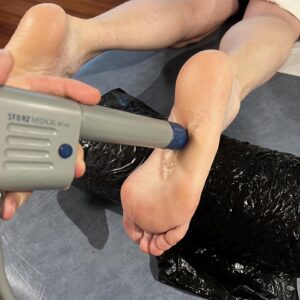Unlock the Healing Power of Shockwave Therapy for Musculoskeletal Pain Relief
Shockwave therapy, also known as Extracorporeal Shockwave Therapy (ESWT), is a groundbreaking, non-invasive treatment option designed to effectively address a variety of musculoskeletal disorders. Utilizing ultrasonic waves directed at specific areas of the body, this therapy targets damaged or inflamed connective tissues, including ligaments and tendons. By delivering sound waves precisely to the affected regions, shockwave therapy significantly boosts the body's natural healing processes. This innovative approach enhances blood circulation and encourages tissue regeneration, making it an attractive alternative for those who prefer to avoid surgical interventions or long-term medication reliance. Many patients experience quicker recovery times and a more comfortable healing journey, making this therapy a favored choice.
Discover the Extensive Benefits of Shockwave Therapy for Long-Term Pain Management
The advantages of shockwave therapy extend well beyond simple pain relief, establishing it as a preferred treatment for individuals grappling with chronic musculoskeletal conditions. Among its most notable benefits are:
Boosting the Body's Natural Healing Processes with Shockwave Therapy
Shockwave therapy effectively targets specific tissues by transmitting sound waves, which leads to enhanced blood flow and improved cellular repair mechanisms. This stimulation significantly amplifies the body's inherent healing abilities, allowing for a more effective recovery of damaged tissues. As a result, patients frequently notice a substantial reduction in rehabilitation times, positioning shockwave therapy as a proactive and efficient recovery strategy that empowers them to swiftly resume their daily activities and lifestyle.
Choosing Non-Invasive Approaches for Pain Management
One of the standout features of shockwave therapy is its non-surgical nature. This characteristic helps patients avoid the inherent risks associated with surgical procedures, such as complications or lengthy recovery periods. Consequently, individuals can return to their everyday routines much more quickly, enjoying a seamless transition back to normalcy without grappling with the adverse effects that commonly accompany invasive medical treatments.
Achieving Effective Pain Management While Minimizing Reliance on Medications
The therapeutic effects of shockwave therapy often lead to substantial relief from pain linked to various conditions. For individuals seeking alternatives to pharmaceutical interventions or invasive surgeries, shockwave therapy presents a highly effective option that manages discomfort while reducing the need for medications. This holistic treatment strategy not only alleviates pain but also fosters a healthier and more sustainable lifestyle, empowering patients to take charge of their health and well-being.
Enhancing Physical Mobility and Overall Quality of Life
After undergoing shockwave therapy sessions, numerous patients report remarkable improvements in their mobility. By effectively targeting the underlying causes of pain and encouraging the repair of damaged tissues, this therapy assists individuals in regaining movement and comfort. The resulting enhancement in physical mobility leads to a significant improvement in overall quality of life, allowing patients to engage more fully in their daily activities and personal interests, from recreational hobbies to regular household tasks.
Cost-Effectiveness of Shockwave Therapy Compared to Traditional Pain Management Options
For many patients, shockwave therapy offers a financially viable alternative to the long-term use of pain medications or surgical treatments. While costs may vary based on individual healthcare requirements and insurance coverage, the potential for considerable savings positions shockwave therapy as an appealing option for those in search of effective pain management solutions that won't strain their budget.
Lower Risk Profile and Minimal Side Effects Compared to Surgical Options
As with any medical treatment, shockwave therapy carries some inherent risks; however, it generally exhibits a lower incidence of adverse effects when compared to surgical alternatives or prolonged medication use. Patients enjoy the therapeutic benefits of this treatment while maintaining a minimized risk profile, making shockwave therapy a safer and more attractive choice for many individuals seeking relief from chronic pain.

Explore the Wide Range of Conditions Treated with Shockwave Therapy
The increasing popularity of shockwave therapy is largely due to its remarkable versatility in addressing a diverse range of musculoskeletal and soft tissue disorders. This innovative treatment has showcased significant efficacy for various conditions, leading to enhanced patient outcomes and higher satisfaction levels.
Common Conditions Effectively Treated by Shockwave Therapy Include:
Foot Conditions: Problems like Plantar Fasciitis and Heel Spurs can severely hinder mobility and disrupt daily life, but shockwave therapy has proven remarkably effective in alleviating these painful conditions and restoring proper function.
Tendinopathies: This category encompasses common issues such as Achilles Tendonitis, Tennis Elbow, and Jumper’s Knee, which can lead to chronic discomfort and significantly impair an individual's quality of life; however, shockwave therapy provides a viable pathway to relief.
Joint Issues: Shockwave therapy has shown effectiveness in treating Stress Fractures and hastening recovery in cases of delayed bone healing, offering patients a reliable route toward recovery and pain reduction.
Calcific Conditions: For those suffering from Calcific Tendonitis, especially in the shoulder area, shockwave therapy can provide significant pain relief and enhance overall function.
Additionally, chronic inflammatory conditions that cause persistent pain, along with complications related to scar tissue and non-healing wounds, can also be effectively managed through this groundbreaking treatment.
Dive into the Various Types of Shockwave Therapy Available
Electrohydraulic Shockwave Therapy (FSWT) for Targeted Pain Relief
Electrohydraulic shockwave therapy employs focused shockwaves to deliver precise treatment to specific areas of pain and injury, effectively facilitating recovery and alleviating discomfort.
Optimal Uses of Electrohydraulic Shockwave Therapy Include:
Pain Management
Soft Tissue Injuries
Musculoskeletal Conditions
Erectile Dysfunction Treatment
Regeneration Therapy
This type of therapy promotes healing and pain relief using low-intensity extracorporeal shockwave therapy (ESWT). Healthcare professionals utilize specialized devices to administer a series of low-energy shockwaves to the affected areas during the procedure. This method stimulates the creation of new proteins and blood vessels, ensuring that the injured region receives enhanced oxygen and nutrients, thereby speeding up the overall healing process.
Utilizing Focused Shockwave Therapy (FSWT) with Electromagnetic Waves for Optimal Healing
Most Effective Applications of Electromagnetic Shockwave Therapy Include:
Cancer Treatment
Spinal Cord Injuries
Brain Tumors
Uterine Fibroids
In medical settings, electromagnetic shockwaves are produced through an electromagnetic field and are successfully applied in treatments like high-intensity focused ultrasound (HIFU) and radiosurgery. HIFU specifically targets tissues such as the prostate or uterus, aiming to heat and destroy abnormal cells, making it a potent option for conditions like prostate cancer and uterine fibroids. Radiosurgery utilizes these shockwaves to deliver concentrated radiation doses to areas like the brain or spine, effectively addressing conditions such as brain tumors and spinal cord injuries.
Advanced Piezoelectric Shockwave Therapy for Kidney and Gallstone Treatment
Key Applications Include:
Kidney Stones
Gallstones
Piezoelectric shockwave therapy, also known as piezoelectric lithotripsy, is a specialized medical procedure that utilizes targeted high-energy shockwaves to effectively fragment kidney or gallstones. This outpatient treatment typically employs ultrasound or X-ray technology to accurately locate the stones within the body. A healthcare provider places a small probe on the skin over the stone, generating a series of high-energy shockwaves that break the stone into smaller pieces. This non-invasive technique allows for easier passage of the stones with minimal discomfort. While piezoelectric lithotripsy is generally regarded as safe and effective, it’s crucial for patients to consult their healthcare provider to determine if this treatment is appropriate for their specific situation.
Comprehensive Pain Management with Radial Shockwave Therapy (RSWT)
Radial shockwave therapy (RSWT) generates unfocused shockwaves that radiate outward, targeting broader areas rather than isolated points. This therapeutic technique is particularly effective for treating extensive tissue zones. The radial pressure waves induce microtrauma in the targeted area, stimulating the body’s natural healing response. RSWT is considered a less invasive, body-focused shockwave therapy, as it does not require precise targeting and is typically performed without sedation or anesthesia. Utilizing lower energy levels, RSWT is frequently employed to treat chronic conditions such as plantar fasciitis, Achilles tendonitis, and various types of tendinopathies, making it an efficient treatment for common orthopedic issues that relieve pain and enhance mobility.
Precision Treatment with Focused Shockwave Therapy (FSWT) for Targeted Recovery
Focused shockwave therapy (FSWT) employs concentrated shockwaves to provide targeted treatment for specific areas of concern. This therapy employs various mechanisms to generate focused waves, including electrohydraulic, electromagnetic, or piezoelectric technologies. Utilizing geometric lenses, these shockwaves concentrate energy within a confined focal area, allowing for deeper penetration into tissue layers. The targeted nature of FSWT promotes healing through mechanotransduction, effectively breaking down scar tissue and calcifications. This therapy is frequently utilized to address persistent conditions such as plantar fasciitis, delayed bone healing, and chronic tendinopathies like tennis elbow. Due to the higher energy levels involved, local anesthesia is often administered during the procedure to ensure patient comfort.
Comparing High-Energy and Low-Energy Shockwave Therapies for Tailored Treatments
Different shockwave technologies make use of high-energy (focused) or low-energy (unfocused) shockwaves to stimulate healing and boost blood flow in injured tissues. The choice between these therapies is determined by the patient's individual needs and medical conditions.
High-energy shockwave therapy, commonly known as focused shockwave therapy, is specifically designed to stimulate the healing of damaged tissues. It delivers high-energy sound waves directly to the injury site, facilitating localized recovery. This method is frequently utilized for treating kidney stones and certain cancers, providing targeted relief and promoting healing.
Examples of High-Energy Focused Shockwave Treatments:
Notable treatment options include GAINSwave, PulseWave, CuraWave, and Swiss DolorClast, each developed to deliver effective therapy for various conditions.
Low-energy shockwave therapy, recognized as low-intensity extracorporeal shockwave therapy (Li-ESWT), promotes tissue healing across a broad spectrum of musculoskeletal disorders, including tennis elbow, golfer's elbow, and plantar fasciitis, as well as chronic pain conditions like neuropathy. This approach enhances the body’s natural healing processes and has demonstrated long-lasting effectiveness in alleviating pain and restoring functional mobility.
Identifying the Best Shockwave Therapy Options for Effective Recovery
Shockwave therapy is readily available at specialized medical centers, clinics, and physiotherapy facilities that focus on advanced treatment for musculoskeletal and soft tissue disorders. These facilities are equipped with cutting-edge technology and staffed by trained medical professionals who create customized treatment plans tailored to each patient’s unique needs and conditions, ensuring a comprehensive and effective approach to recovery.
Stimulating Natural Healing Processes with Shockwave Therapy
Shockwave therapy effectively stimulates targeted tissues by transmitting sound waves, resulting in improved blood circulation and heightened cellular repair activities. This dynamic process significantly enhances the body’s intrinsic ability to heal itself, allowing damaged tissues to be treated more efficiently and reducing the overall time needed for rehabilitation.
Choosing Non-Invasive Approaches for Pain Management
One of the most remarkable features of shockwave therapy is its non-surgical nature. This characteristic allows patients to bypass the inherent risks associated with surgical procedures and the lengthy recovery periods that typically follow. Consequently, individuals can return to their daily activities with greater ease, avoiding the complications often linked with invasive treatments.
Achieving Effective Pain Management While Reducing Medication Dependency
The therapeutic benefits of shockwave therapy can lead to significant relief from pain associated with various conditions. For those seeking alternatives to pharmaceutical treatments or invasive surgical options, shockwave therapy emerges as a valuable choice that effectively manages discomfort while decreasing reliance on medications. This holistic treatment strategy not only alleviates pain but also supports a healthier, more sustainable lifestyle, empowering patients to regain control over their health.
Enhancing Physical Mobility and Quality of Life
Following shockwave therapy sessions, many patients experience substantial improvements in their mobility. By effectively addressing the underlying causes of pain and stimulating the repair of damaged tissues, this therapy helps individuals regain movement and comfort. The resulting enhancement in physical mobility leads to a notable improvement in overall quality of life, enabling patients to engage more fully in their everyday activities and interests, from recreational hobbies to routine household tasks.
Cost-Effectiveness of Shockwave Therapy Compared to Traditional Pain Management Methods
For a broad range of patients, shockwave therapy presents a cost-effective alternative to the long-term use of pain medications or surgical interventions. While prices may vary based on individual healthcare needs and insurance coverage, the potential for substantial savings makes shockwave therapy an attractive option for those in search of effective pain management solutions that won't strain their finances.
Lower Risk Profile and Minimal Side Effects Compared to Surgical Procedures
Like any medical treatment, shockwave therapy does come with some inherent risks; however, it generally presents a lower incidence of side effects compared to surgical options or long-term medication regimens. Patients benefit from the therapeutic effects of this treatment while also maintaining a minimized risk profile, making shockwave therapy a safer and more appealing choice for many individuals seeking relief from chronic pain.
Essential Resources for Understanding Extracorporeal Shockwave Therapy (ESWT)
American Academy of Orthopaedic Surgeons (AAOS):
Website: https://orthoinfo.aaos.org/
The AAOS provides extensive patient education resources and articles on a wide range of orthopedic treatments, including ESWT.
Mayo Clinic:
Website: https://www.mayoclinic.org/
Mayo Clinic offers comprehensive information on medical conditions and treatment options, including ESWT, within their patient care section.
WebMD:
Website: https://www.webmd.com/
WebMD provides health information and resources for patients, including articles and videos detailing ESWT and its various applications.
National Institute of Arthritis and Musculoskeletal and Skin Diseases (NIAMS):
Website: https://www.niams.nih.gov/
NIAMS, part of the National Institutes of Health (NIH), offers research-based information on musculoskeletal conditions and treatments, including ESWT.
The Article: Extracorporeal Shockwave Therapy: Unveiling Its Potential appeared first on https://mcrtherapies.co.uk
The Article Extracorporeal Shockwave Therapy: Exploring Its Benefits appeared first on https://mcrtherapies.com/
The Article Extracorporeal Shockwave Therapy Benefits Explored Was Found On https://limitsofstrategy.com/


The discussion around shockwave therapy as a non-invasive treatment for musculoskeletal pain is particularly timely, given the growing emphasis on exploring holistic and technology-driven alternatives to traditional medical interventions. Your insights into the mechanism and benefits of Extracorporeal Shockwave Therapy (ESWT) resonate with many patients who are often seeking options to manage pain effectively while minimizing the potential side effects and risks associated with surgery and long-term medication use.
You’ve captured a really important aspect of the discussion surrounding shockwave therapy. The search for holistic and technology-driven alternatives reflects a broader shift in how we approach health and wellness today. Many patients I’ve spoken with are genuinely curious about non-invasive options that empower them to take control of their pain management journey.
I completely resonate with your perspective on the importance of exploring non-invasive options like shockwave therapy. It really highlights a shift in our collective consciousness around health and wellness, doesn’t it? The growing curiosity among patients suggests they’re not just passive recipients of treatment anymore; they want to be active participants in their care.
You’ve touched on something really important. The shift in how people approach their health is fascinating. There’s this movement away from just accepting whatever the doctor prescribes to a much more engaged and informed perspective. Patients asking questions and seeking alternatives like shockwave therapy is a sign that they want more from their healthcare experiences.
You’ve really touched on something essential here. The exploration of non-invasive treatments like shockwave therapy resonates deeply with many people who are looking for ways to manage their health without heavy reliance on medications or invasive procedures. This current trend reflects a growing awareness and desire for solutions that are both effective and respectful of the body’s natural healing processes.